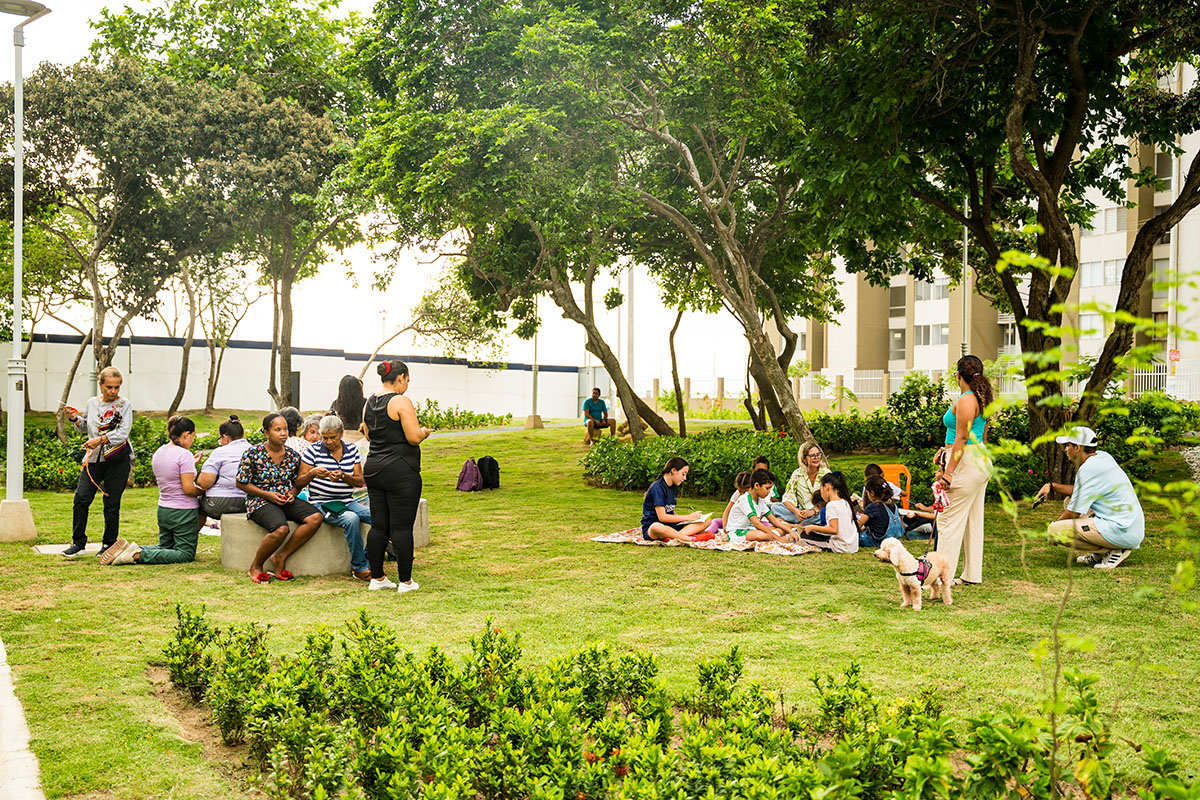In the spirit of the COP 30 Presidency’s call for a global mutirão – a collective effort to mobilize climate action – the Business Council for Sustainable Energy (BCSE) will lead a business delegation to COP 30 in Belém, Brazil that will bring forward credible solutions, partnerships, investments, and ideas to accelerate the energy transition and decarbonize agriculture, buildings, industry, and transportation. This case study is part of BCSE’s Granary of Solutions to deliver emissions reductions, increase resilience, and meet energy transition goals worldwide.
Highlights:
- “The most important urbanism project in the Atlantic” incorporates sustainable, regenerative design to create a socially inclusive community for 50,000 people
- Will provide 1,440 affordable housing units and connect previously fragmented communities with public parks and green spaces
- Restores wetlands and provides floodable parks and sustainable urban drainage systems to support resilience and climate adaptation
Case Study:
In the municipality of Puerto Colombia, Atlántico, the construction of Ciudad Mallorquín is under way. This urban project, led by Grupo Argos, is not only transforming the way of living in the Colombian Caribbean, but is also raising the standard for what it means to build a city-scale project in the 21st century.
Ciudad Mallorquín was conceived from the conviction that inclusive housing can exist in harmony with the natural environment. With over 16,000 housing units – 90% of which are classified as affordable housing (VIS, in its initials in Spanish) – and a projected population of 50,000 people, Ciudad Mallorquín is directly addressing the region’s housing deficit. This is achieved through a comprehensively master-planned community model that combines environmental sustainability, social inclusion and regenerative urbanism with a long-term vision. The project has recently been recognized with precertification under LEED v4.1 with the U.S. Green Building Council‘s LEED for Communities rating system, a rigorous program for sustainable urban planning and design.
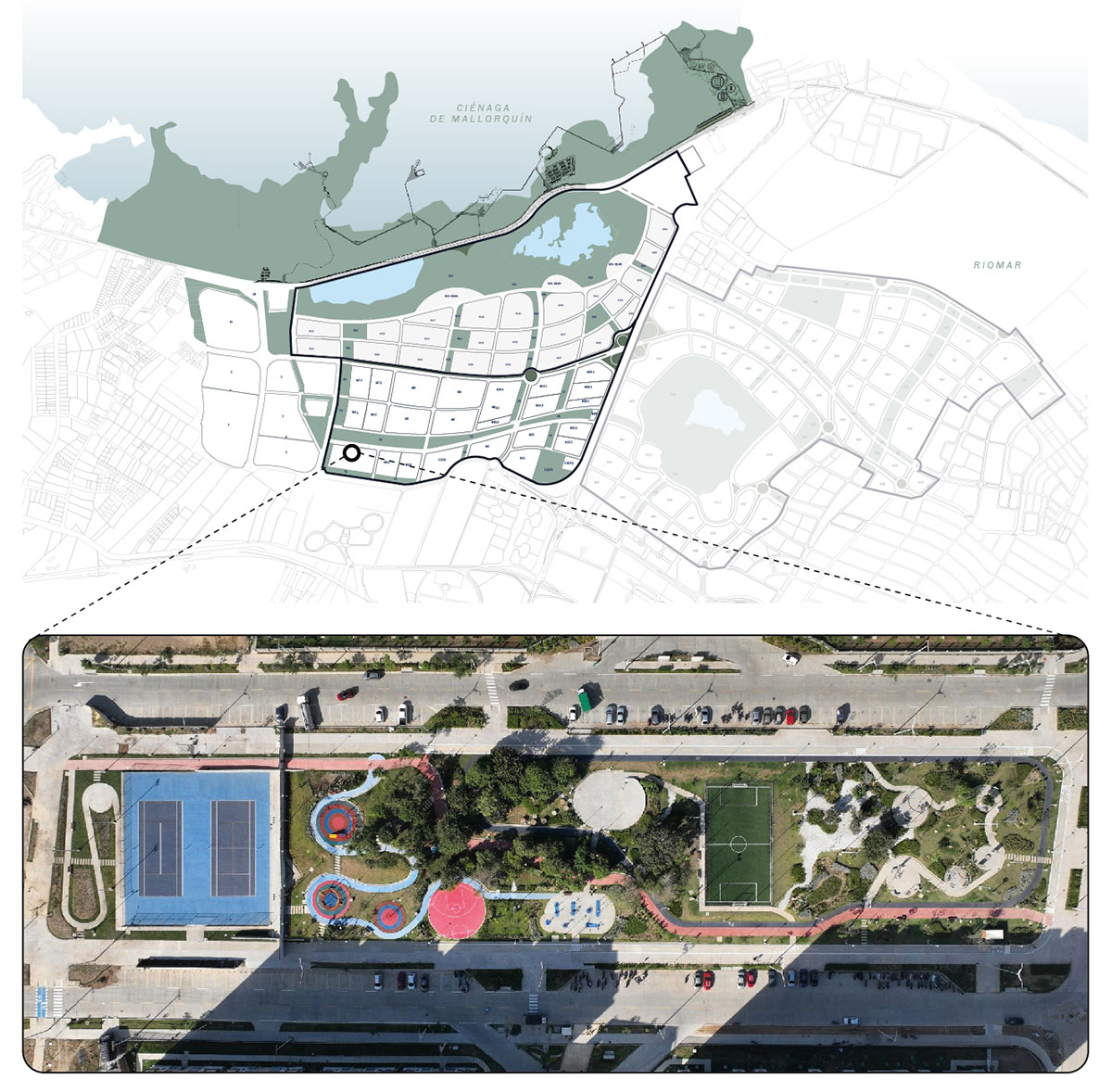
Park system of the master plan – Sector 1 of El Tesoro park. Image credit: Grupo Argos.
LEED for Communities as a tool to align standards
The LEED for Communities precertification is not just a distinction. It validates that the project meets global standards in energy efficiency, water management, responsible material selection and quality urban design.
From 2021 to 2024, numerous urbanism and co-creation workshops were held with architects, experts and local communities for the Ciudad Mallorquín project. In these sessions, stakeholders focused on ways to bring together compact, complete, identity-rich urban centers, enhancing the sense of belonging and ensuring economic prosperity and social cohesion. This collective effort resulted in the conceptualization and design of a comprehensive master plan, featuring mixed land uses, a network of diverse public spaces, and a variety of housing types and socioeconomic levels that foster social interaction – making this development unique in Colombia and the Caribbean.
This approach was also central to the LEED for Communities certification criteria, showing how regenerative planning can align with global standards without losing sight of the local context and the Caribbean spirit.
Ciudad Mallorquín is not just a resilient project. It is a living example of ecological, social and economic regeneration.
“With more than 260 projects globally and 55 in Latin America, LEED for Communities rating system is used by developers like Grupo Argos to integrate and validate sustainability, equity and regenerative principles in planning and designing of large-scale communities,” says Vatsal Bhatt, Ph.D., vice president at USGBC for the LEED for Communities program. “However, USGBC strongly encourages operation, management and continuous improvement of these communities, with the performance indicators embedded in this rating system and online tools that make dynamic data available on people’s fingertips,” he adds.
Urban regeneration strategies
An adaptive reuse site of 2.1 square kilometers replaces a former stone quarry. It will include a residential community and nearly 730,000 square meters of public parks and green spaces—comprising some of the largest urban parkland in the area.
By reconnecting previously fragmented communities, the project fosters collective identity and belonging. It has created a seamless urban connection between Puerto Colombia and Barranquilla—two adjoining cities, with clearly defined urban nodes that give each sector a distinct identity and promote economic and cultural exchange.
Ecological regeneration strategies
One of the most inspiring aspects of Ciudad Mallorquín is its relationship with the ecosystem. Rather than denying the needs of the environment, it embraces them.
Wetlands were restored for the project. Native species were planted. A community nursery was created. These are not isolated or symbolic actions – they are part of a comprehensive nature-based solutions strategy, including one led by the Von Humboldt Institute for the project team, aiming to adapt the project’s parks to the conditions of the tropical dry forest and to combat climate change by mitigating sea-level rise and the heat island effect.
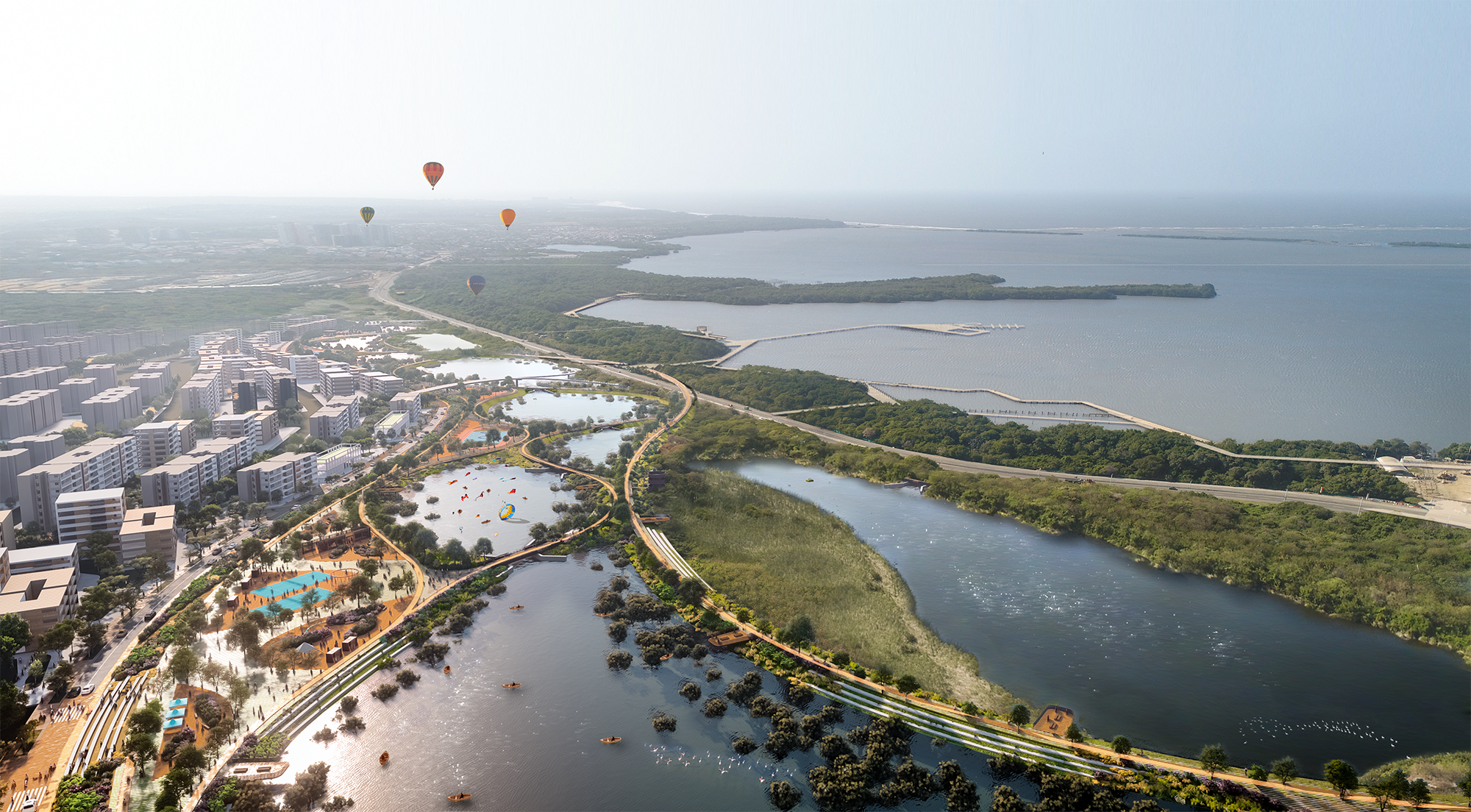
Wetland restoration is an integral part of the project. The rendering shows the future park design vision, featuring nature-based solutions within the master plan. Image credit: Grupo Argos.
Floodable parks and sustainable urban drainage systems (SUDS) were integrated, not only as technical solutions, but also as educational tools that help communities learn to coexist with nature (as done in a nearby ecopark project).
Through the regenerative design workshops hosted by the project, ecological goals were set for 5- and 20-year time spans, using bioindicators to guide and measure the project’s actual impact. These goals include
- Ensuring that at least 15% of the project comprises active green areas (public spaces that encourage recreation and relaxation).
- Replacing 75% of invasive species with native ones in public spaces.
- Restoring substrates and improving water quality through SUDS.
- Conserving at least 60% of native species from the reference ecosystem.
- Attracting at least 10% of desirable animal species through plant-animal interactions.
- Promoting structural diversity (e.g., layers, trophic levels, spatial complexity).
- Establishing ecological connectivity through green corridors and wildlife crossings.
Workshops on natural connections also aimed to integrate these corridors and protect critical areas such as the spawning grounds of the blue crab, an endemic species now actively linked to the park and the project’s urban structure.
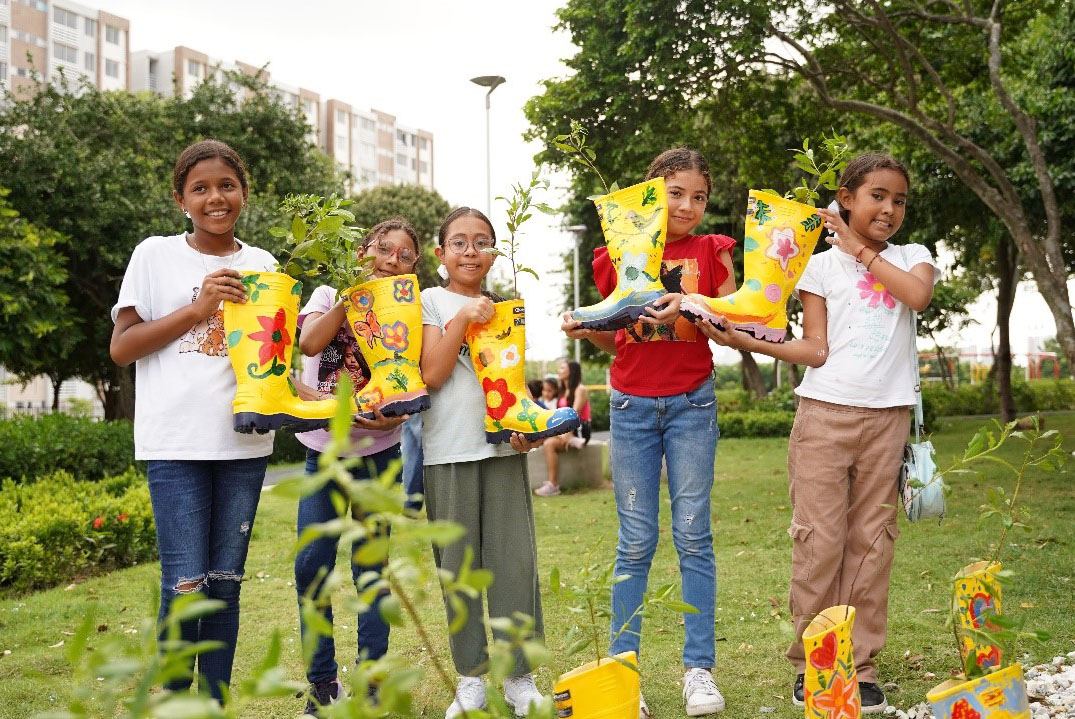
Children take part in an educational workshop on mangrove planting in El Tesoro park. Photo credit: Grupo Argos.
Sustainable construction with social purpose
More than a dozen renowned developers are participating in the construction of Ciudad Mallorquín, all following strict sustainability guidelines. Durable, low-maintenance materials are prioritized, along with efficient construction waste management strategies and life cycle/ environmental impact reduction criteria.
But perhaps the greatest value lies in the process itself: It has been built with the community. Co-creation processes and participatory workshops have helped define urban design elements, strengthen social fabric and promote sustainable practices—fostering a sense of ownership among residents even before they move in. This approach not only builds belonging, but also encourages shared responsibility and social resilience.
Through various activities and initiatives, such as classes, entrepreneurship fairs, and knitting groups, the community gathers and connects in parks envisioned in the master plan. These spaces serve as catalysts for social cohesion, reinforcing residents’ connection to their environment.
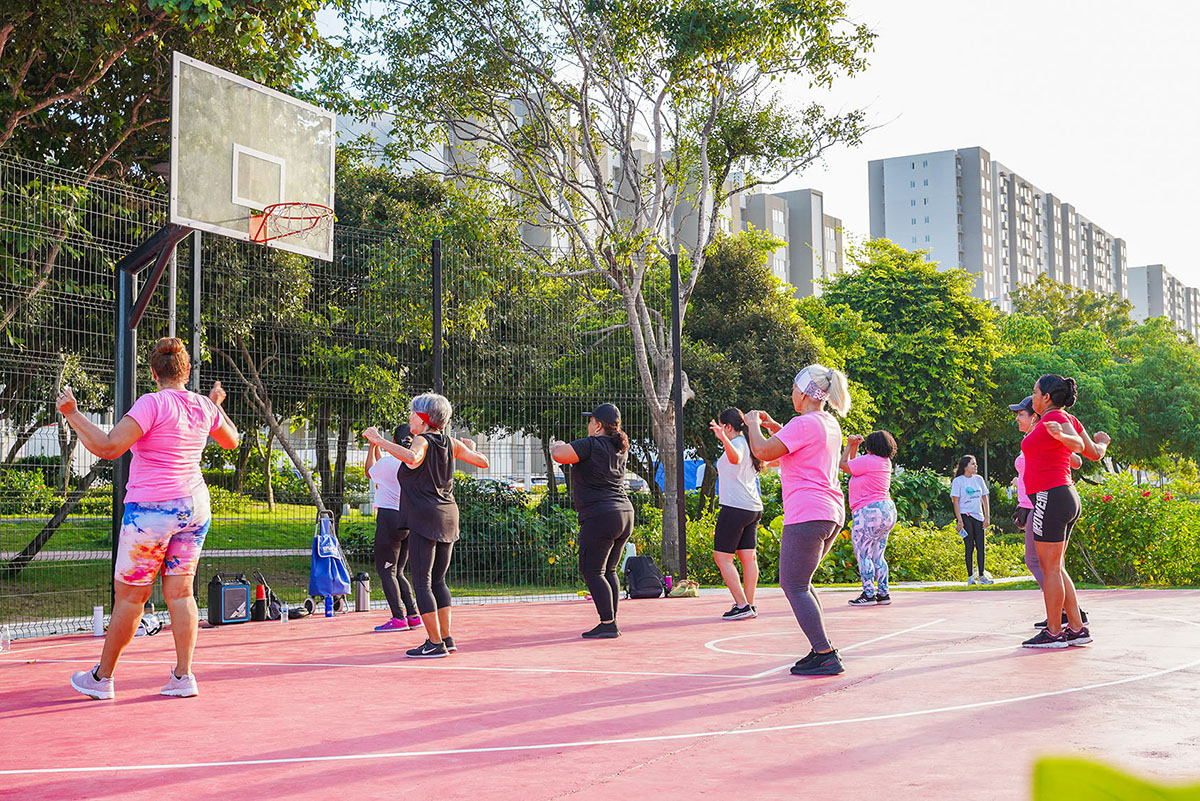
Aerobics activities are held in the park. Photos credit: Grupo Argos.
A walkable and bikeable community
From its inception, Ciudad Mallorquín was envisioned as a “city within a city,” inspired by the 15-minute city concept, where people can walk or bike to key services such as health care, education, retail, recreation and public transport.
The urban layout is structured around a central 70,000-square-meter urban park, over 775,000 square meters of public space, 12 kilometers of bike paths, and tree-lined sidewalks that promote active mobility, neighborly encounters and respect for the natural environment. Road and public space designs followed international pedestrian and cyclist-first manuals.
This type of compact, mixed-use urbanism not only reduces CO2 emissions and car dependency; it also significantly improves quality of life. It’s about giving people back their time, creating complete communities—dense yet balanced—and avoiding the structural failures of sprawling urban growth.
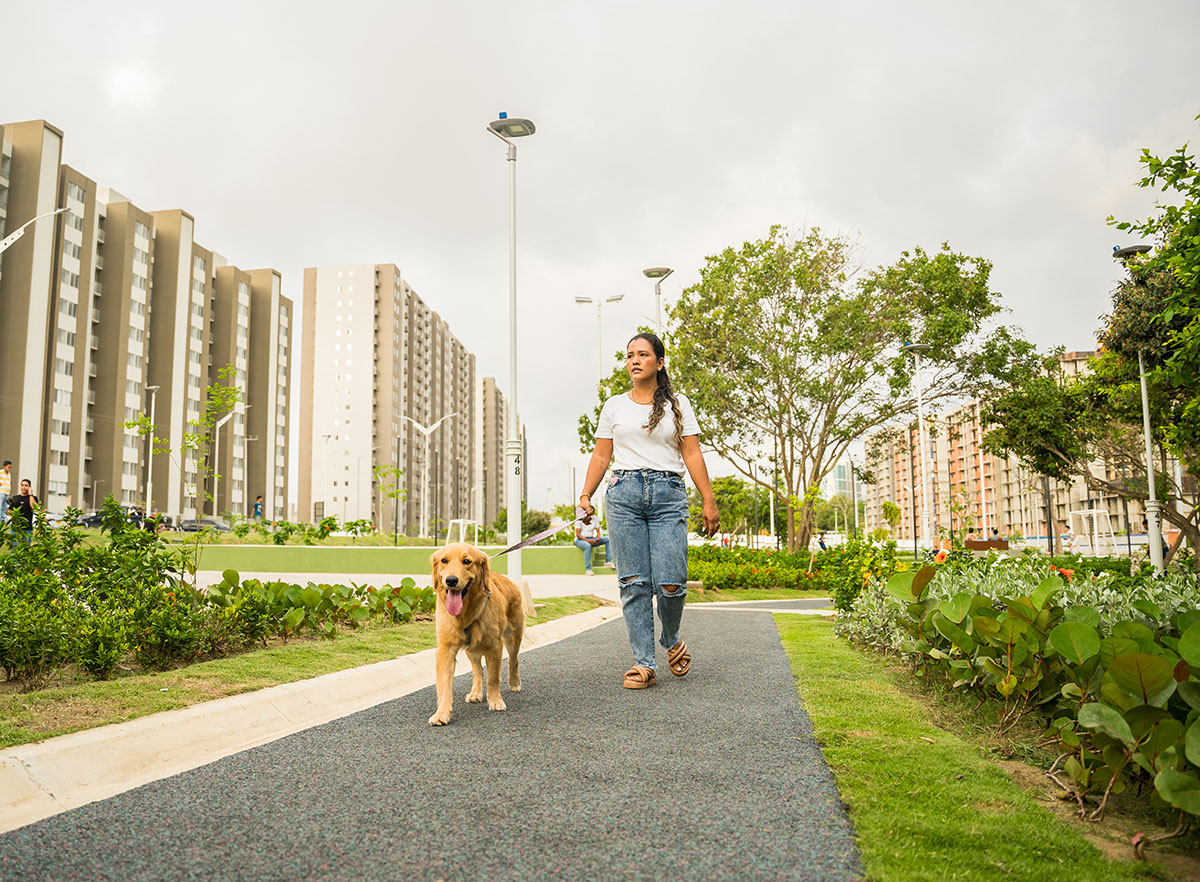
A network of bike paths and sidewalks is laid out in the central park. Photo credit: Grupo Argos.
Economic regeneration
According to studies conducted by Camacol, the Colombian Chamber of Construction, more than 3,000 direct and 6,500 indirect jobs were generated during the construction phase. With this job creation and an investment exceeding USD 595 million, Ciudad Mallorquín also acts as an economic engine. It is anticipated to double the municipality’s property tax revenue, thereby strengthening its fiscal sustainability.
An urban model for the country (and the future)
Inspired by examples such as Ciudad Salitre in Bogotá and Puerto Madero in Buenos Aires, Ciudad Mallorquín is emerging as a new icon of sustainable urban development in Colombia and Latin America. It proves that it’s possible to transform without destroying, to grow without excluding, and to build without forgetting the land’s natural history and soul. Communities that don’t just mitigate, but that restore, are the kind we need to multiply.

